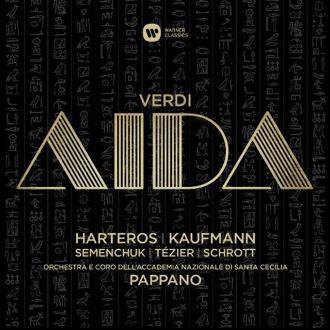|
|
|
|
|
|
|
|
| Gramophone |
|
|
VERDI Aida
|
|
 Aida
is the most classically concise of the great 19th-century grand operas yet
it remains the one most closely associated with theatrical excess. To savour
its qualities, it should be heard first, seen later, which is why the
gramophone has played so important a role in its performing history.
Nowadays record companies mainly serve up opera on DVD or in cheap-to-record
concert performances. Yet, as Antonio Pappano has had the courage to insist,
you cannot record Aida in concert. Set in temple and tomb, by river and city
gate, the sound planes are too various, the range of dynamics too complex to
replicate in concert-hall conditions. Aida
is the most classically concise of the great 19th-century grand operas yet
it remains the one most closely associated with theatrical excess. To savour
its qualities, it should be heard first, seen later, which is why the
gramophone has played so important a role in its performing history.
Nowadays record companies mainly serve up opera on DVD or in cheap-to-record
concert performances. Yet, as Antonio Pappano has had the courage to insist,
you cannot record Aida in concert. Set in temple and tomb, by river and city
gate, the sound planes are too various, the range of dynamics too complex to
replicate in concert-hall conditions.
Aida received its first
complete studio recording in Rome in 1928 but it was the 1959 Decca
recording – produced in Vienna by John Culshaw with Karajan conducting a
largely Italian cast – that finally gave us what Andrew Porter, writing in
these columns, called ‘a sound realisation of the score which transcends any
shortcomings inherent in physical staging and brings us a step closer to
that ideal imagined performance’. Not that the Decca set displaced the
theatrically thrilling, albeit more conventionally produced, 1955 Serafin
recording with Maria Callas as Aida and Tito Gobbi as a near definitive
Amonasro.
The new recording, produced by Stephen Johns, stands within
that broad EMI tradition, albeit with a larger stage picture and a greatly
enhanced dynamic range beautifully accommodated to the opera’s need, and the
listener’s. Where the new set resembles the 1959 Decca is in the quality of
the conducting. Pappano’s direction, like Karajan’s, is organic as the work
is organic: each episode finely shaped within itself (the Triumphal Scene is
beautifully judged) yet built unerringly into the larger whole. I don’t hear
this to the same extent in Muti’s 1974 EMI recording and certainly not in
the 1961 RCA set, where a strong cast headed by Leontyne Price and Jon
Vickers has to do battle with Solti’s brazen and occasionally thoughtless
conducting.
Karajan has the Vienna Philharmonic but it is arguable
that Pappano goes one better, with orchestral playing of rare accomplishment
from an Italian ensemble which is alive to the opera’s every word. (And
motion: the ballet sequences are superbly realised.) In both performances
the orchestra is a powerful additional player which supports the singers at
every turn. The result is a vocally lyrical Aida with Pappano’s cast, like
Karajan’s, never needing to force the moment. We hear this at the very
outset in Jonas Kaufmann’s account of ‘Celeste Aida’, less visceral than
some but wonderfully mellifluous and crowned by a rarely heard quietly
diminishing high B flat.
Anja Harteros is arguably the most
interesting Aida on record since Callas, albeit differently characterised.
Where Callas is every inch the lovelorn warrior princess, Harteros is a
humane and articulate Aida who is palpably not the mistress of her destiny.
Her top C near the end of ‘O patria mia’ is neither as pianissimo nor as
dolce as Caballé’s on the Muti recording, but that – for all but the most
ardent canary-fancier – is beside the point when Caballé lacks the power
persistently to outface Fiorenza Cossotto’s dauntless Amneris and is never
as at one with her Radamčs, Plácido Domingo, as Harteros is with the leonine
yet liquid-toned Kaufmann.
It matters little in an intelligently
produced studio recording that of the principals only Ekaterina Semenchuk
has sung her role on stage, though her Amneris is indeed one of the finest
on record. Ludovic Tézier is an impressive Amonasro. Apart from an
indistinct final syllable on ‘Ei t’ama’ as Amonasro confronts his daughter
with the fact of Radamčs’s love for her, he is a consistently strong player.
Marco Spotti makes a plausible King, but Erwin Schrott’s High Priest sounds
too benign to be the regime’s political enforcer.
Pappano has already
given us an exceptional recording of the Messa da Requiem (EMI, 10/09),
which Verdi wrote shortly after Aida. The concentrated quiet of the choral
work in the temple scenes, where Eleonora Buratto contributes an exquisite
High Priestess, echoes this. In the trial scene and the lovers’ entombment,
the new recording perhaps deploys too few tricks. I rather miss Culshaw’s
contrived but subtly layered acoustic picture; and prefer hieratic brass
which is palpably nel sotterraneo as Verdi directs. (The 1955 Serafin
recording has this exactly right.) But the singing of the doomed lovers has
tenderness and beauty, and the preternaturally quiet Santa Cecilia
string-playing is exquisitely managed as the drama makes its longed-for
tryst with silence.
No recording is without the occasional oddity of
balance and perspective. And Warner’s booklet is poor, preferring a PR puff
to an essay on the opera itself. But these are minor matters in the presence
of what is as fine an all-round Aida as the gramophone has yet given us. |
|
|
|
|
|
|
|
|
|
|
|
|